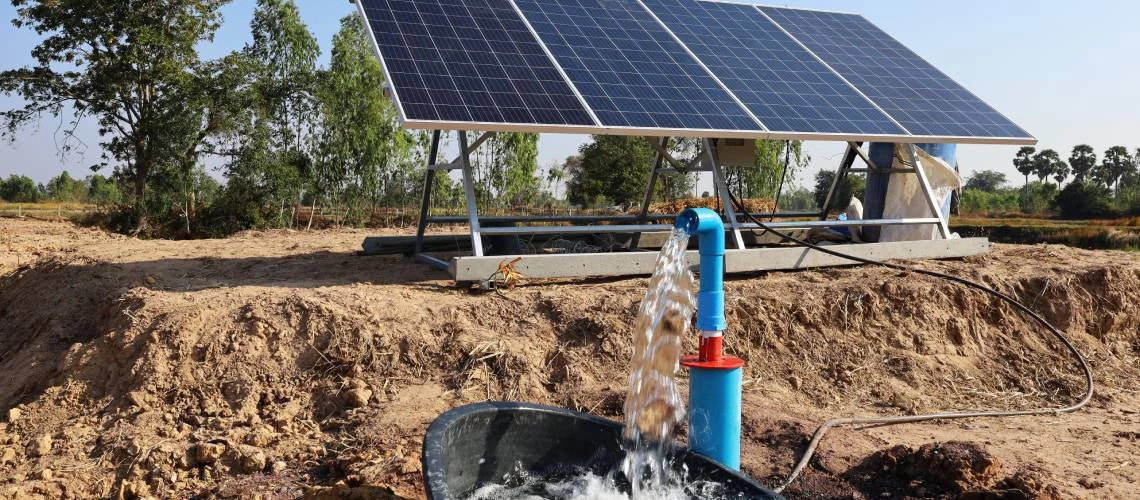 Groundwater is extracted with a submersible pump powered by solar energy
Groundwater is extracted with a submersible pump powered by solar energy
Solar-powered groundwater irrigation is growing quickly in low and middle-income countries (LMICs). Over the last ten years, South Asia has seen the installation of more than 500,000 small standalone pumps, while in Sub-Saharan Africa, solar pumps are becoming a crucial technology for expanding irrigated agriculture. These solar pumps hold significant potential to meet the increasing energy needs of impoverished farmers in LMICs. Studies from South Asia and Sub-Saharan Africa indicate that standalone solar pumps lead to improvements in food production, food security, and livelihoods—essential factors for reducing poverty.
However, the swift adoption of solar pumps also brings risks that require careful monitoring to guide policies and investments. Firstly, while solar pumps contribute to energy expansion through renewables, they might not necessarily result in a significant reduction in greenhouse gas emissions. The complete replacement of a fossil fuel pump with a solar pump isn't guaranteed; farmers might use multiple energy sources to meet diverse needs, maintain functionality regardless of daylight or weather conditions, or manage various non-contiguous plots. Additionally, the adoption of solar pumps could incentivize farmers to make changes to land use and input choices that increase carbon-intensive practices, such as expanding cropping areas, using more agrochemicals, and cultivating water-intensive crops. These changes may lead to a net increase in greenhouse gas emissions. Assessing and tracking the complex and expensive net effects of such changes, especially in LMICs where farms are small and numerous, poses a significant challenge.
Even in cases where solar-powered irrigation is carbon neutral, it is likely to increase groundwater usage due to zero pumping costs. While this can be beneficial for improving water security and livelihoods in areas with supportive hydrogeology, it may pose risks in regions already heavily reliant on groundwater. Policymaking progress should involve clearly defining the achievable objectives of solar irrigation while closely monitoring its limitations and risks concerning carbon emissions and groundwater depletion. Integrated approaches to accounting and regulation across scales can ensure that solar irrigation contributes to poverty alleviation without causing long-term harm.
Drawing insights from entrepreneurship and market design can help provide solar-powered irrigation services to small-scale cultivators, particularly in Sub-Saharan Africa, where food insecurity is a growing concern. Improving the quality and scope of information on water, land, and energy use is crucial, requiring a shift from isolated to integrated approaches. Ground-based observation networks can enhance public information on water availability and variability. Leveraging existing data collection efforts by national statistics offices can prioritize indicators on water, land, and energy use. Additionally, incorporating telemetry in solar pumps with built-in sensors can enhance monitoring capabilities.
A realistic assessment of the technical and logistical costs, complexities, and expected returns from linking solar irrigation with carbon credit programs in LMICs should be undertaken to set realistic expectations. Investments in solar pumps should be coupled with efforts to measure and manage the risks associated with groundwater depletion. This comprehensive approach ensures that the benefits of solar irrigation are maximized while mitigating potential drawbacks.
Read the full paper in Science, co-authored by The World Bank’s Soumya Balasubramanya, Esha Zaveri, and Aude-Sophie Rodella, in collaboration with authors from universities and research institutions in the Global North and Global South.
Read the report The Hidden Wealth of Nations: Groundwater in Times of Climate Change, edited by The World Bank’s Aude-Sophie Rodella, Esha Zaveri and François Bertone.


Join the Conversation